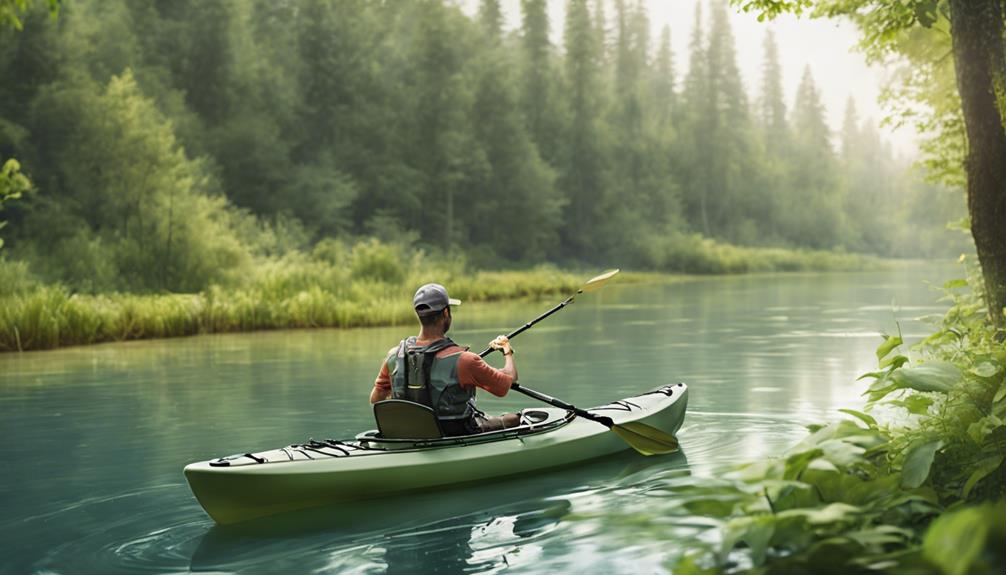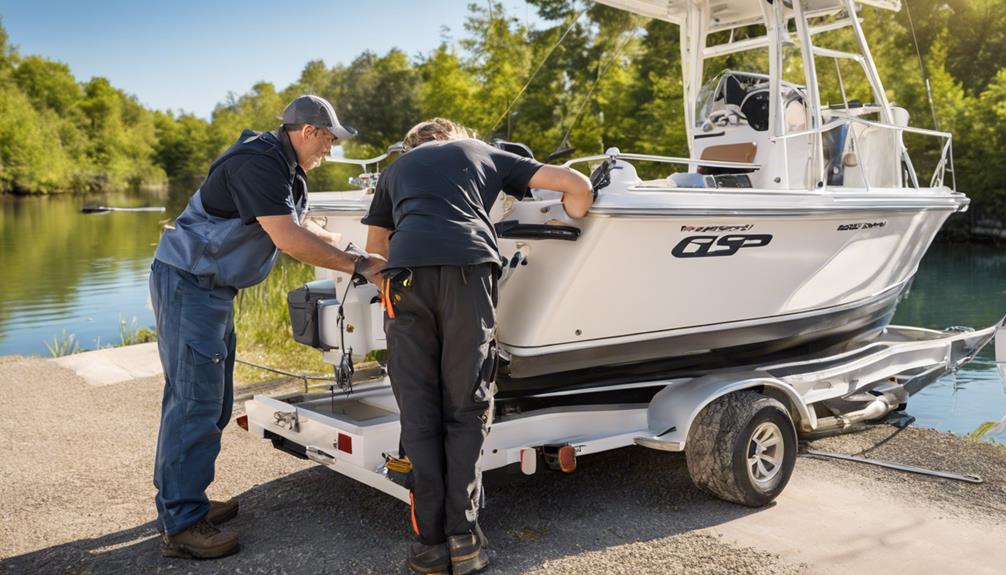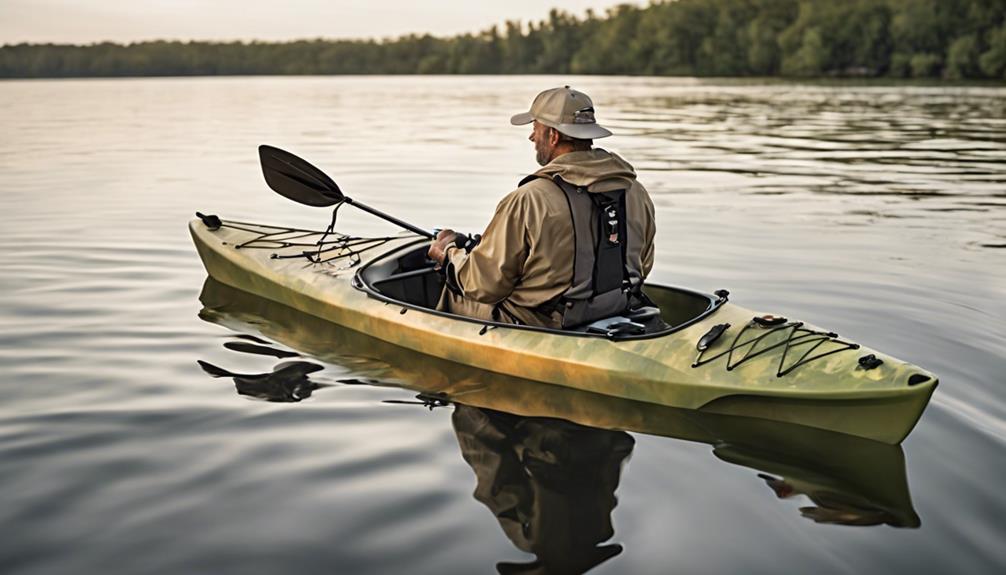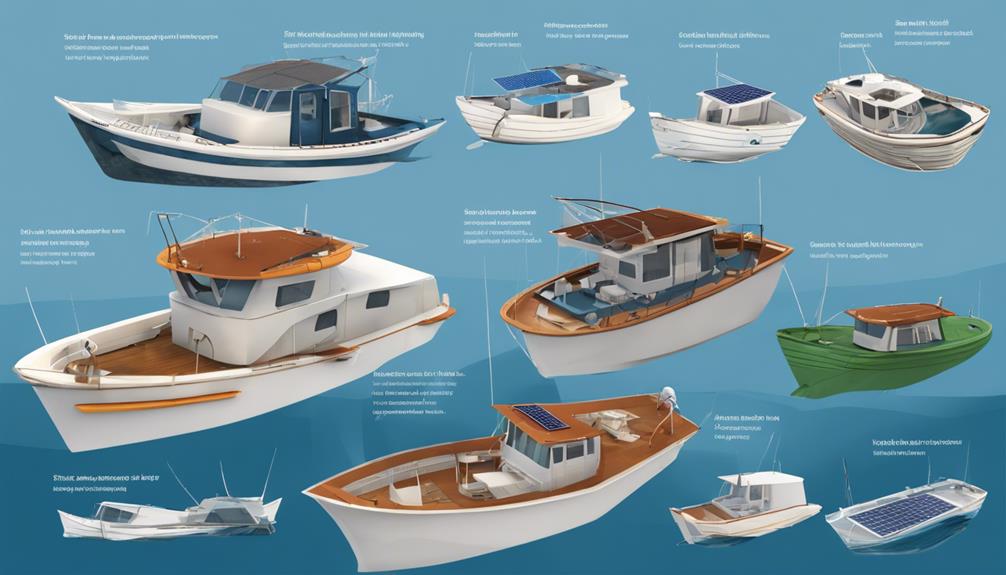Are you searching for the perfect fishing kayak for your river adventures?
Imagine effortlessly gliding through river bends and casting your line with precision. But what makes river-suitable fishing kayaks stand out from the rest?
The answer lies in their specialized features designed to tackle the unique challenges of river fishing. From stability in swift currents to maneuverability around rocky obstacles, these kayaks offer a blend of functionality and performance that will elevate your angling experience to new heights.
Stability on Moving Waters
To navigate moving waters safely, ensure your fishing kayak provides excellent stability. When dealing with river currents, stability techniques are crucial for a smooth and secure ride. Kayak design plays a significant role in ensuring your safety on the river.
River currents can be unpredictable and strong, making it essential to have a stable fishing kayak. Look for a kayak with a wider hull and a flat bottom. These design features provide better stability by distributing your weight evenly and reducing the chances of tipping over in turbulent waters. Additionally, sit-on-top kayaks are known for their stability and are a popular choice for river fishing due to their design and ease of use.
When navigating moving waters, practicing proper stability techniques is key. Keep your center of gravity low by sitting or kneeling in the kayak's center. Use your paddle as a brace against the current to maintain balance. By using these techniques in combination with a well-designed fishing kayak, you can confidently tackle various river conditions while staying safe on the water.
Remember that stability isn't just about the kayak—it also depends on your skills and awareness of river safety. Stay vigilant, understand the river currents, and always wear your personal flotation device for added security. With the right kayak and proper techniques, you can enjoy a stable and secure fishing experience on the river.
Maneuverability Around River Obstacles
Enhance your ability to navigate river obstacles efficiently by mastering kayak maneuverability techniques. When it comes to maneuvering around river obstacles, having a strong grasp of paddle techniques is key. Utilize quick, short strokes to navigate tight spots and eddies effectively. By mastering different paddling techniques such as draw strokes, sweep strokes, and braces, you can easily maneuver your fishing kayak around rocks, branches, and other obstacles that may come your way.
In addition to paddle techniques, understanding specific river techniques is crucial for maneuvering around obstacles. Learning how to read the river's currents and eddies will help you anticipate obstacles and plan your route accordingly. By using the river's natural flow to your advantage, you can navigate through challenging sections with ease.
Consider making kayak modifications and investing in specialized river gear to enhance your maneuverability on the water. Add a skeg or rudder to your kayak to improve tracking and control, especially in swift currents or windy conditions. Additionally, equip yourself with a sturdy paddle leash, helmet, and proper footwear to ensure safety while maneuvering around river obstacles.
Lightweight Design for Portaging
Mastering kayak maneuverability techniques not only helps you navigate river obstacles efficiently but also emphasizes the importance of a lightweight design for portaging. When it comes to portaging, the last thing you want is a heavy kayak that becomes a burden to carry over land. A lightweight fishing kayak ensures efficient transport from one water body to another, making your overall kayaking experience more enjoyable.
A kayak designed with portaging in mind is crafted to be light enough for easy handling out of the water. This feature is particularly beneficial when you encounter areas where you need to carry your kayak around obstacles or between different bodies of water. The ease of lifting and moving a lightweight kayak allows you to navigate portages with minimal strain, ensuring that you can quickly get back to the water to continue your adventure.
Choosing a fishing kayak with a lightweight design not only facilitates portaging but also contributes to overall convenience during your trips. The reduced weight makes loading and unloading your kayak from your vehicle a hassle-free task. Additionally, a lighter kayak enhances maneuverability on land, enabling you to traverse various terrains with ease. Ultimately, opting for a lightweight fishing kayak prioritizes efficiency and ease of use, enhancing your overall kayaking experience.
Ample Storage for Fishing Gear
Crafted with the angler in mind, fishing kayaks designed with ample storage ensure you can easily organize and access your gear while on the water. Tackle organization is made simple with dedicated compartments and trays that keep your lures, hooks, and bait sorted. No more rummaging through a tangled mess; everything has its place, allowing you to focus on what truly matters – catching fish.
Rod holders are a crucial feature of fishing kayaks, providing a hands-free solution for managing your fishing rods while you navigate the river currents. Securely place your rods in the holders, keeping them within arm's reach for quick access when a fish strikes. This convenience not only enhances your fishing experience but also ensures your rods are safely stored, preventing damage during transportation.
With strategically placed storage hatches and bungee cords, you can stow away larger items such as tackle boxes, extra clothing, or even a small cooler for refreshments. The versatility of storage options in river-suitable fishing kayaks allows you to pack everything you need for a successful day on the water without compromising on space or accessibility. Stay organized, keep your gear protected, and focus on reeling in your next big catch with a fishing kayak built to meet your storage needs.
Enhanced Tracking in River Currents
When navigating river currents in your fishing kayak, maintaining enhanced tracking is essential for optimizing your angling experience. Improved handling in river currents is crucial to ensure you can easily maneuver your kayak to reach your desired fishing spots without being carried away by the water's flow. Kayaks designed for river fishing often feature enhanced performance capabilities that aid in tracking effectively. These enhancements typically include features such as pronounced keels or skegs that help the kayak maintain a straighter course, even when faced with challenging currents.
Having improved handling in your fishing kayak allows you to focus more on fishing rather than constantly readjusting your position in the river. Enhanced performance features not only make your kayaking experience more enjoyable but also increase your chances of successfully reeling in that big catch. With better tracking abilities, you can confidently navigate varying river conditions, from calm waters to swift currents, without sacrificing control over your kayak.
Investing in a fishing kayak with enhanced tracking capabilities can make a significant difference in your overall angling experience. The combination of improved handling and enhanced performance ensures that you can efficiently navigate river currents, stay on course, and concentrate on what truly matters – enjoying the serenity of the river and catching fish.
Comfort Features for Long River Trips
For a more enjoyable and relaxing experience during long river trips, consider incorporating comfort features into your fishing kayak. When embarking on extended journeys, comfort becomes paramount. Seat cushioning is crucial to prevent discomfort and fatigue, enabling you to focus on the serenity of the river. Adjustable footrests are equally essential, providing support and allowing you to customize your leg position for optimal comfort and stability throughout the trip.
Additionally, having convenient storage options like paddle holders and rod holders can enhance your comfort by keeping your gear within easy reach. Paddle holders secure your paddles when not in use, preventing them from rolling around and cluttering your kayak. Rod holders offer a hands-free solution for managing your fishing rods, allowing you to relax and enjoy the scenery without having to constantly hold onto your equipment.
Durability Against River Conditions
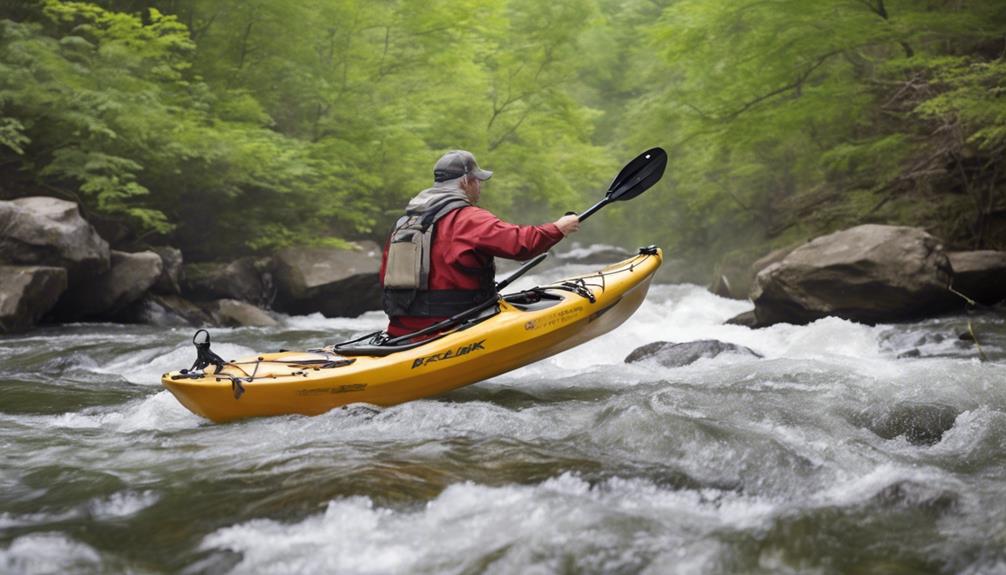
To ensure your fishing kayak can withstand the challenging conditions of the river, prioritize durability features that resist wear and tear from water exposure and rough terrain. When choosing a kayak for river fishing adventures, consider the following key factors:
- Material Strength and Water Resistance:
Opt for kayaks constructed from durable materials like high-density polyethylene (HDPE) or composite materials. These materials are known for their strength and ability to resist the corrosive effects of water, ensuring your kayak remains sturdy and reliable even after prolonged use in river environments.
- Impact Resistance and Abrasion Protection:
Look for kayaks with reinforced hull designs that can withstand impacts from rocks, logs, and other obstacles commonly found in river settings. Additionally, kayaks with built-in abrasion protection features such as skid plates or keel strips can help prevent damage to the hull when navigating shallow or rocky riverbeds.
- Sealed Compartments and Secure Fastenings:
Ensure your fishing kayak is equipped with sealed compartments to keep your gear dry and secure during river expeditions. Additionally, opt for kayaks with reliable fastenings such as heavy-duty buckles or straps to prevent gear from shifting or falling off in turbulent river waters.
Safety Features for River Adventures
Prioritize your safety on river adventures by equipping your kayak with essential safety features. When setting out on a river excursion, it's crucial to have proper emergency preparedness measures in place. One key safety feature is a personal flotation device (PFD) that fits well and is worn at all times while on the water. In case of an emergency, a whistle attached to your PFD can help signal for help. Additionally, carrying a first aid kit and a throw rope can be lifesaving in unexpected situations.
Another vital aspect of safety on river adventures is mastering proper paddle technique. Understanding how to navigate strong currents, eddies, and obstacles is essential for a safe and enjoyable trip. Practicing efficient paddle strokes, such as the forward stroke, sweep stroke, and draw stroke, can help you maneuver your kayak effectively through different river conditions. It's also important to learn how to brace and roll your kayak in case of capsizing.
Furthermore, consider installing deck lines on your kayak to provide additional safety. Deck lines can assist in re-entering your kayak after a capsize and offer a secure grip in swift currents. Remember, safety should always be the top priority when embarking on river adventures. By incorporating these safety features and honing your paddle technique, you can enhance your enjoyment while staying prepared for any situation that may arise.
Frequently Asked Questions
Are Fishing Kayaks Suitable for Use in Whitewater Rapids?
Fishing kayaks can be used in whitewater rapids, but it's crucial to consider kayak stability and whitewater safety. River fishing from a kayak requires different techniques compared to still waters.
Make sure your kayak is suitable for whitewater conditions to ensure your safety. Practice your fishing skills in calmer waters before tackling the rapids.
Always prioritize safety and take the necessary precautions when venturing into whitewater environments.
How Do You Properly Secure Your Fishing Gear in a Kayak on Fast-Moving Rivers?
When tackling fast-moving rivers in a kayak, securing your fishing gear properly is crucial. Prioritize gear organization to maintain kayak stability.
Use safety measures like leashes and tie-downs to prevent items from shifting. Opt for kayaks with ample equipment storage options.
What Additional Safety Precautions Should Be Taken When Fishing in a River With Strong Currents?
When fishing in rivers with strong currents, prioritize river safety. Be aware of current concerns by checking the water conditions beforehand. Always wear a life jacket and consider using a helmet for added protection. Secure your gear properly to avoid accidents.
Stay alert and avoid risky areas. Remember, your safety is key when enjoying fishing in fast-moving rivers.
Can Fishing Kayaks Handle Rough River Conditions Like Rocks and Debris?
When navigating obstacles like rocks and debris in rough river conditions, fishing kayaks can handle them well. However, it's crucial to take extra safety precautions.
Always wear a life jacket, stay alert, and avoid risky areas. Choose a kayak suited for rivers to ensure stability and durability.
Are There Any Specific Techniques or Gear Recommendations for Fishing in Rivers With Varying Water Levels?
When fishing in rivers with varying water levels, it is essential to adapt your techniques. Use riverbank fishing strategies for changing depths. Organize your tackle efficiently for easy access.
Consider using adjustable bobbers and weights to match the current. Stay flexible and switch lures as needed. Keep a variety of bait options handy.
Stay observant of the water flow and adjust your position accordingly. Stay safe and enjoy the dynamic challenges of river fishing.
Conclusion
So, when choosing a fishing kayak for river adventures, opt for one that offers stability, maneuverability, and durability on moving waters.
Look for lightweight designs with ample storage and enhanced tracking capabilities.
Comfort features and safety measures are also essential for long river trips.
With the right kayak, you can enjoy a successful and enjoyable fishing experience on the river.
Happy fishing!
